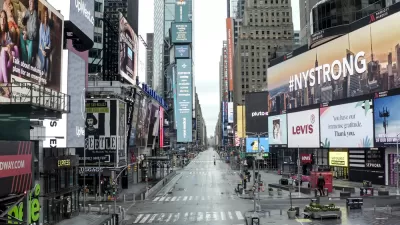International immigration to the country’s most populous areas tripled even as major metropolitan areas continued to lose population.

“The number of immigrants nearly tripled in the nation’s 20 most populous counties from 2021 to 2022, as immigration returned to prepandemic levels nationally, the Census Bureau reported on Thursday.” According to a New York Times article by Robert Gebeloff, Dana Goldstein, and Stefanos Chen, “Many of the newcomers were drawn to big cities with more liberal immigration laws and longstanding immigrant enclaves.”
Despite the rebound in international immigration, many of the country’s top counties lost population overall. “Los Angeles County in California, Cook County, which includes Chicago, in Illinois, and the boroughs of Brooklyn and Queens in New York all lost population, but the loss was smaller than in 2021.” Meanwhile, more affordable Sunbelt metro areas continued to draw more new internal migrants.
One exception was, surprisingly, New York City’s priciest borough. “Manhattan, the stand-in of choice for urban doomsayers, had a sharp turnaround: The borough added 17,472 residents in 2022, after a loss of nearly 100,000 the previous year — the biggest improvement in the nation.” The article notes it is the first time Manhattan saw a net gain in domestic migration since 2000 or earlier, despite sharply rising housing costs. “The median rent in Manhattan in June 2022, at the end of the census reporting period, was nearly $4,000, including landlord concessions — a jump of more than 28 percent from the same month the previous year.”
FULL STORY: Immigration Tripled in Top U.S. Counties Even as Many of Them Lost Population

Planetizen Federal Action Tracker
A weekly monitor of how Trump’s orders and actions are impacting planners and planning in America.

Maui's Vacation Rental Debate Turns Ugly
Verbal attacks, misinformation campaigns and fistfights plague a high-stakes debate to convert thousands of vacation rentals into long-term housing.

Restaurant Patios Were a Pandemic Win — Why Were They so Hard to Keep?
Social distancing requirements and changes in travel patterns prompted cities to pilot new uses for street and sidewalk space. Then it got complicated.

In California Battle of Housing vs. Environment, Housing Just Won
A new state law significantly limits the power of CEQA, an environmental review law that served as a powerful tool for blocking new development.

Boulder Eliminates Parking Minimums Citywide
Officials estimate the cost of building a single underground parking space at up to $100,000.

Orange County, Florida Adopts Largest US “Sprawl Repair” Code
The ‘Orange Code’ seeks to rectify decades of sprawl-inducing, car-oriented development.
Urban Design for Planners 1: Software Tools
This six-course series explores essential urban design concepts using open source software and equips planners with the tools they need to participate fully in the urban design process.
Planning for Universal Design
Learn the tools for implementing Universal Design in planning regulations.
Heyer Gruel & Associates PA
JM Goldson LLC
Custer County Colorado
City of Camden Redevelopment Agency
City of Astoria
Transportation Research & Education Center (TREC) at Portland State University
Jefferson Parish Government
Camden Redevelopment Agency
City of Claremont





























